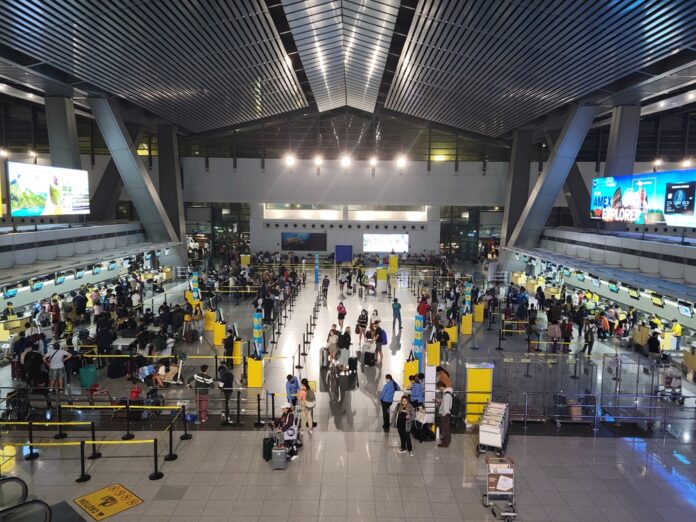The Manila International Airport Consortium on Monday unveiled the P267-billion masterplan for the redevelopment of the Ninoy Aquino International Airport, an unsolicited proposal that will rival the Bulakan airport project of San Miguel Corp.
The proposed multi-year rehabilitation and development plan for NAIA is aimed at more than doubling the capacity of the Philippines’ main gateway to around 70 million passengers a year in 2048 from the current 31 million. Under the first phase of the plan, the airport capacity will be immediately increased to 54 million passengers per annum by 2025, then to 62.5 million by 2028 with the expansion and development of terminal floor area, additional airfield facilities and improvement in cross-terminal transportation.
“The Manila International Airport Consortium recognizes the immense task of transforming NAIA to meet the exponentially growing demands of Mega Manila air travel, not only in the here and now but also in the future,” said Kevin Tan, chairman and president of Alliance Global – InfraCorp Development Inc. “It is because of this that the members of the Consortium have pooled together its significant resources, technical expertise and operational experience to put forward a NAIA Masterplan.”
The masterplan has been submitted to Department of Transportation and the Manila International Airport Authority as an unsolicited proposal under the Public-Private Partnership framework to introduce technological, structural and operational changes to the NAIA under a 25-year concession agreement.
“Reliable transport infrastructure is a key challenge for the Philippines and the rehabilitation of NAIA for the long-term is essential if Manila is to become the regional economic hub we know it can be.”
Dr. Jim Yong Kim, vice chairman and partner at Global Infrastructure Partners
GIP is one of the leading infrastructure investors and airport operators in the world, whose portfolio of airports include international hubs such as London Gatwick Airport, Sydney Airport, and Edinburgh Airport. It is the technical partner of MIAC, whose other members include six of the Philippines’ largest conglomerates, namely Aboitiz InfraCapital, Inc., AC Infrastructure Holdings Corporation, Asia’s Emerging Dragon Corp., Alliance Global – Infracorp Development Inc., Filinvest Development Corp., and JG Summit Infrastructure Holdings Corporation.
Some of the members of the consortium were also included in Asia’s Emerging Dragon Corp., a company formed in 1993 by several Filipino taipans to bid for the upgrade the Manila’s international airport but lost to the controversial Philippine International Air Transport Corp. AEDC renewed its interest in the airport project in 2016.
By 2028, it is projected that NAIA will welcome 55 million passengers—well above its declared capacity of 31 MPPA. Before the pandemic, NAIA had already breached this ceiling when it registered a peak of 47.9 million passengers in 2019.
Cosette Canilao, previous head of the PPP Center and now president and chief executive officer of Aboitiz InfraCapital, said the unsolicited proposal of MIAC is the fastest route to rehabilitate and modernize NAIA.
“The unsolicited procurement mode of the BOT Law is a powerful tool of the government to fast track infrastructure development provided the proposal is properly prepared, backed by credible and qualified proponents, and adheres to the rules, policies and guidelines of the government. MIAC’s unsolicited proposal unequivocally meets all those criteria. We have done the homework: it is a turnkey proposal ready for government evaluation, and has the financing to get boots and shovels on the ground,” she said.
Josephine Gotianun-Yap, president and CEO of Filinvest Development, said the redevelopment of NAIA is a critical core in Mega Manila’s airport strategy, suggesting it will complement and not compete with the San Miguel airport project.
“NAIA’s importance and economic impact cannot be overstated, especially since it has an ecosystem of supporting infrastructure that would take decades for greenfield airport developments to replicate,” said Gotianun-Yap, adding: “It is necessary for NAIA’s comprehensive modernization to happen in parallel with the development of greenfield airports.”
San Miguel’s New Manila International Airport project was expected to operate by 2027, with an initial capacity of 35 million passengers a year before capacity is increased to 100 million. The $15 billion airport project included an economic zone area but bill allowing the development and operation of the econzone was vetoed by President Ferdinand Marcos Jr. on July 1 last year, a day after assuming the presidency. The airport project isn’t affected by the veto but raises questions about its viability.







